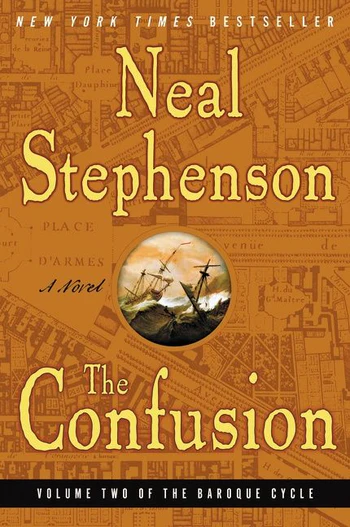The Confusion

ISBN: 9780060733353
The Confusion is a hard-to-characterize work. One can say, as many have, that it is the follow-up to Stephenson’s Quicksilver, and that is factually true. However, it does not adequately convey the scope and type of work that is put into play in this sequel.
It is probably easiest to say that The Confusion is about a long chain of transactions that are devised as a way for slaves, namely the episodic anti-hero Jack Shaftoe, to become rich. The way in which this richness is to occur snakes through the corridors of Alchemy and into the gold of King Solomon who is thought to be, at least for the sake of the novel, the Greatest Alchemist.
Whereas Quicksilver establishes the philosophical Mercury that becomes the Royal College, The Confusion becomes the domain of Elizabeth from the first novel. The Alchemy has shifted from a type of philosophy to types of currencies and markets. The literal quicksliver, that is to say liquid mercury, is used to mint coins and no less of a personage is called to the Royal Mint in London than Issac Newton. His new job is to run the mint itself and to make sure the currency looks the best that it can.
In the meantime, Jack Shaftoe, who was taken as a slave in the previous work, forms a cabal with his fellow slaves to begin an ambitious type of piracy that they hope will culminate in their mutual enrichment. These piracy trades which touch against the networks that Elizabeth knows all too well eventually culminate in paths intersecting in unexpected ways. At each interval, one is reminded of the quicksilver in one way or another, what it heralds and how it has transformed not only the hard currency but those involved with it following its trail whether through esoteric understanding or avaricious understanding.
The amount of trade discussion in this book is overkill even for a seasoned economist. Generally speaking, one can subdivide the activity into "has gold, loses gold, devises some other partnership or trade to get gold back, loses gold, someone else gets gold that is involved in a trade that Elizabeth is making and very occasionally despises or does not understand the significance of the Solomonic Gold. This goes on for nearly a thousand pages. The history is researched well, and the story has many other activities interspersed such as the various French and British tensions and battles that happen in their respective time periods. There is no doubt that Stephenson lived the writing of this trilogy since the kind of writing done is only the kind that comes from going out and experiencing the world firsthand that one wishes to describe.
If there is a failing, it might be that Stephenson is perhaps too clever at times for his own good. The novel sometimes reads like he is trying to prove something about his own understanding of the subject but the way in which he chooses to do so is heavy-handed. An Oxford professor who uses obscure words to a class of Freshman might be a fitting description. It could also be that he has identified the audience most likely to read this work, and so he has written for those who are of a more academic inclination who are more likely to run across some of the recondite information he has accrued and crafted a story around. It is at times a grinding, irritating read, but resolves into areas that are worth the wait.
